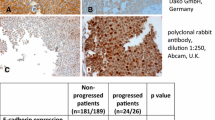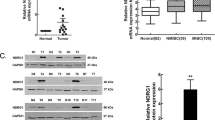Abstract
This study aimed to assess the expression of S100A4, Twist and E-cadherin (mRNA and protein) in urothelial bladder cancer, investigate the correlation between them and evaluate their association with the clinicopathological features of the disease. The study included 54 patients diagnosed as urothelial bladder cancer of different stages and grades. The expression levels of S100A4, Twist and E-cadherin (mRNA and protein) in tissue samples were determined by quantitative RT-PCR and immunohistochemistry. The expression of S100A4 and Twist was significantly upregulated while E- cadherin was significantly downregulated in urothelial bladder cancer tissues compared to the adjacent surrounding normal bladder tissues at both mRNA and protein levels (p < 0.001). Expression levels of S100A4 and Twist were significantly higher in recurrent tumor than in non-recurrent tumors (p < 0.001) while the expression level of E-cadherin was significantly lower in recurrent tumors than in non-recurrent tumors at both mRNA and protein levels (p < 0.001). There was a significant positive correlation between S100A4 and Twist expressions (r = 0.875, p < 0.001) while significant negative correlations were found between E- cadherin and S100A4 expressions(r=- 0.803, p < 0.001) and between E-cadherin and Twist (r = −0.809, p < 0.001). Up-regulation of S100A4 and Twist and down-regulation of E-cadherin in urothelial bladder cancer tissues compared to adjacent normal tissues were observed. There was a significant negative correlation between S100A4 and E- cadherin and between E- cadherin and Twist expression. However, there was a significant positive correlation between S100A4 and Twist expressions. Furthermore, the alterations in the gene expression were associated with disease stage and grade.







Similar content being viewed by others
Abbreviations
- EMT:
-
Epithelial-mesenchymal transition
- RT-PCR:
-
Reverse Transcriptase-Polymerase Chain Reaction
- H&E:
-
Hematoxylin and eosin
- SCC:
-
Squamous cell carcinoma
- ROC:
-
Receiver operating characteristics
- ANOVA:
-
Analysis of variance
References
Jemal A, Siegel R, Xu J et al (2010) Cancer statistics, biomolecular predictors of urothelial cancer behavior and treatment outcomes. CA Cancer J Clin 60(5):277–300
Ibrahim AS, Khaled HM, Mikhail NN et al (2014) Cancer incidence in Egypt: results of the national population-based cancer registry program. J Cancer Epidemiol. doi: 10.1155/2014/437971
Jankovic S, Radosavljevic V (2007) Risk factors for bladder cancer Tumori 93:94
Rink M, Cha EK, Green D et al (2012) Biomolecular predictors of urothelial cancer behavior and treatment outcomes. Curr Urol Rep 13(2):122–135
Barbieri CE, Lotan Y, Lee RK et al (2010) Tissue-based molecular markers for bladder cancer. Minerva Urol Nefrol 62(3):241–258
Shiota M, Tsunoda T, Song Y et al (2011) Enhanced S100 calcium-binding protein p expression sensitizes human bladder cancer cells to cisplatin. BJU Int 107:1148–1153
Yang XC, Wang X, Luo L et al (2013) RNA interference suppression of A100A4 reduces the growth and metastatic phenotype of human renal cancer cells via NF-κB-dependent MMP-2 and bcl-2 pathway. Eur Rev Med Pharmacol Sci 17:1669–1680
Boye K, Maelandsmo GM (2010) S100A4 and metastasis: a small actor playing many roles. Am J Pathol 176:528–535
Wang H, Duan L, Zou Z et al (2014) Activation of the PI3K/Akt/mTOR/p70S6K pathway is involved in S100A4-induced viability and migration in colorectal cancer cells. Int J Med Sci 11(8):841–849
Hugo H, Ackland ML, Blick T et al (2007) Epithelial–mesenchymal and mesenchymal–epithelial transitions in carcinoma progression. J Cell Physiol 213:374–383
Kuwabara Y, Yamada T, Yamazaki K et al (2008) Establishment of an ovarian metastasis model and possible involvement of E-cadherin down-regulation in the metastasis. Cancer Sci 99:1933–1939
Singh A, Settleman J (2010) EMT, cancer stem cells and drug resistance: an emerging axis of evil in the war on cancer. Oncogene 29:4741–4751
Martin TA, Goyal A, Watkins G, Jiang WG (2005) Expression of the transcription factors Snail, Slug, and Twist and their clinical significance in human breast cancer. Ann Surg Oncol 12:1–9
Yu Q, Zhang K, Wang X, Liu X, Zhang Z (2010) Expression of transcription factors snail, slug, and twist in human bladder carcinoma. J Exp Clin Cancer Res 29:119
Cheng L, Montironi R, Davidson DD et al (2009) Staging and reporting of urothelial carcinoma of the urinary bladder. Mod Pathol 22(2):S70–S95
Niu Y, Wang L, Cheng C et al (2015) Increased expressions of SATB1 and S100A4 are associated with poor prognosis in human colorectal carcinoma. APMIS 123(2):93–101
Koksal IT, Ates M, Danisman A et al (2006) Reduced E-cadherin and alpha-catenin expressions have no prognostic role in bladder carcinoma. Pathol Oncol Res 12(1):13–19
Tang X, Xing J, Li W, Wu Z, Zhang K, Zheng J (2013) Expression of transcription factor Twist1 in bladder urothelial carcinoma and its clinical significance. J BUON 18(1):211–219
Zheng YL, Amr S, Saleh DA et al (2012) Urinary bladder cancer risk factors in Egypt: a Multicenter case-control study. Cancer Epidemiol Biomarkers Prev 21(3):537–546
Cabezon T, Celis JE, Skibshoj I et al (2007) Expression of S100A4 by a variety of cell types present in the tumor microenvironment of human breast cancer. Int J Cancer 121:1433–1444
Hernández JL, Padilla L, Dakhel S et al (2013) Therapeutic targeting of tumor growth and angiogenesis with a novel anti-S100A4 monoclonal antibody. PLoS ONE 8(9):e72480
Agerbaek M, Alsner J, Marcussen N et al (2006) Focal S100A4 protein expression is an independent predictor of development of metastatic disease in cystectomized bladder cancer patients. Eur Urol 50:777–785
Yao R, Lopez-Beltran A, Maclennan GT et al (2007) Expression of S100 protein family members in the pathogenesis of bladder tumors. Anticancer Res 27:3051–3058
Kwak JM, Lee HJ, Kim SH et al (2010) Expression of protein S100A4 is a predictor of recurrence in colorectal cancer. World J Gastroenterol 16:3897–3904
Zhang HY, Zheng XZ, Wang XH et al (2012) S100A4 mediated cell invasion and metastasis of esophageal squamous cell carcinoma via the regulation of MMP-2 and E-cadherin activity. Mol Biol Rep 39(1):199–208
Fondrevelle ME, Kantelip B, Robert RE, Chopin DK, Thiery JP, Monnien F, Bittard H, Wallerand H (2009) The expression of Twist has an impact on survival in human bladder cancer and is influenced by the smoking status. Urol Oncol 27:268–276
Zhang Z, Xie D, Li X et al (2007) Significance of Twist expression and its association with E-cadherin in bladder cancer. Hum Pathol 38:598–606
Feng MY, Wang K, Shi QT, Yu XW, Geng JS (2009) Gene expression profiling in TWIST-depleted gastric cancer cells. Anat Rec 292:262–270
Lukanidin E, Sleeman JP (2012) Building the niche: the role of the S100 proteins in metastatic growth. Semin Cancer Biol 22(3):216–225
Mishra SK, Siddique HR, Saleem M (2012) S100A4 calcium-binding protein is key player in tumor progression and metastasis: preclinical and clinical evidence. Cancer Metastasis Rev 31(1–2):163–172
Author information
Authors and Affiliations
Corresponding author
Rights and permissions
About this article
Cite this article
Hussein, S., Mosaad, H., Rashed, H.E. et al. Molecular factors regulating E-cadherin expression in urothelial bladder cancer and their correlations with the clinicopathological features. Mol Biol Rep 44, 365–377 (2017). https://doi.org/10.1007/s11033-017-4118-z
Received:
Accepted:
Published:
Issue Date:
DOI: https://doi.org/10.1007/s11033-017-4118-z




